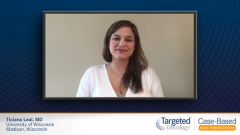
Defining Platinum Sensitivity vs Resistance after First-Line Treatment in Small Cell Lung Cancer
Dr Ticiana Leal, MD, lists the treatment options associated with first-line therapy and its relation to platinum sensitivity.
Episodes in this series

Ticiana Leal, MD: In the frontline setting, the data are pretty clear that we use the combination of chemotherapy with immunotherapy. We talked about using the immunotherapy agent durvalumab based on the CASPIAN data and atezolizumab based on IMpower133 data followed by the maintenance strategy.
As we talked about, the vast majority of patients are going to have progression of their disease on their frontline regimen. While it’s not very well established what and how to define platinum sensitivity or platinum resistance, we do have some clinical guidelines of how we define that. From a clinical trial standpoint, some of the trials have defined platinum sensitivity or platinum resistance using a cutoff of 90 days or greater. If patients have had their prior platinum 90 or more days ago, these are considered patients who are platinum sensitive. If they’ve had progression of their disease on their prior platinum for less than 90 days, that’s considered platinum resistant.
That’s a great measure for using that definition in a clinical trial. However, in the clinical setting as a standard of care, we generally define platinum sensitivity as greater than 180 days. If their prior platinum was greater than 180 days, we would consider rechallenging with the platinum again. If patients have good tolerability of their prior platinum-etoposide, we obviously take that into account vs if they have a hard time with their prior regimen and if they have significant complications of their prior platinum regimen. Obviously, that would be something that may sway you to move on to a second-line regimen that is different from the rechallenge strategy.
The rechallenge strategy is a relatively good strategy. It’s a better strategy when we don’t have options in second-line that are beneficial or promising or that have high toxicity. For a long time, we struggled with second-line topotecan as our next regimen given the significant toxicity—especially myelosuppression—when we used topotecan in the second-line setting. The response rate of topotecan in the resistant population is around 5% with high rates of toxicity. That would certainly sway you to perhaps rechallenge a patient in the frontline setting, especially if they had platinum-sensitive disease.
The data for platinum-sensitive rechallenge is based on a small series of patients, but it is something that we would consider again today.
Transcript edited for clarity.
Case: A 61-Year-Old Man With Small-Cell Lung Cancer
Initial Presentation
- A 61-year-old man presented with a cough, fatigue, progressive shortness of breath
- PMH: unremarkable
- SH: 25-pack year smoking history; social alcohol use
- PE: Right lower lobe wheezing on auscultation, axillary lymph node enlargement
Clinical Workup
- Labs: WNL
- Axillary lymph node biopsy revealed small cell carcinoma
- Chest/abdomen/pelvic CT showed a 7.1 cm mediastinal conglomerate mass, with invasion into the right main and lobar pulmonary arteries; 2 small left pulmonary nodules; hypermetabolic axillary lymph node
- PET scan showed large focal hypermetabolic activity in the mediastinum and small hypermetabolic activity in the surrounding area
- Contrast‐enhanced MRI of the head showed no brain metastases
- Stage IV small-cell lung cancer; ECOG PS 0
Treatment
- Initiated carboplatin + etoposide + atezolizumab for 4 cycles; followed with atezolizumab as maintenance therapy
Follow-up
- 7 months after starting treatment he complained of shortness of breath, right upper quadrant pain and back pain
- CT showed hematogenous metastases in the liver and right adrenal gland
- Initiated lurbinectedin 3.2 mg/m2 IV q21 Days







































